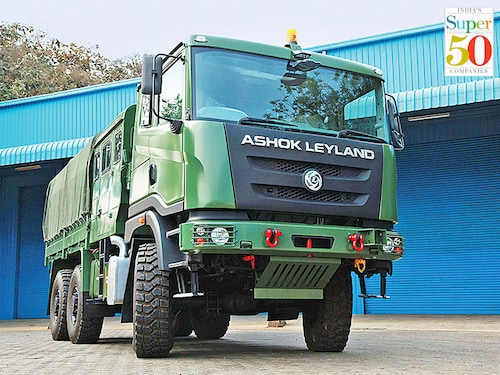Ashok Leyland: Upwardly mobile
The truck maker has come a long way since experiencing firsthand the vagaries of the macro economy. It's now looking to reduce its dependence on trucks


Ashok Leyland’s revenues from vehicles in the defence segment grew 32 percent in FY18
The trucking sector rolls on the wheels of the macro economy. The former’s fate has almost always been closely intertwined with the latter. Just ask Ashok Leyland about its bumpy ride between 2012 and 2014.
In FY13, the truck maker’s revenues dipped 2.63 percent from the previous year, while profits slumped 23 percent. The following fiscal, revenues dropped another 20 percent to ₹10,010 crore and the firm posted a paltry ₹29 crore in profit.
In the annual report for fiscal 2013, Dheeraj Hinduja, chairman of Ashok Leyland, indicated the slump was emblematic of the economic slowdown. “With the Indian economy clocking a modest 5 percent GDP growth last year [2012], a far cry from the nearly 9 percent annual expansion only two years ago, the overall commercial vehicle segment suffered a 2 percent negative growth over the previous year. In that contraction, the medium and heavy duty segment, the company’s stronghold, declined 25 percent.” Ashok Leyland claimed that industry volumes slumped 43 percent between FY12 and FY14, even as competition from new entrants intensified.
Cut to 2018 and Ashok Leyland is firing on all cylinders. The firm sold 1,74,873 vehicles in FY18, clocking ₹1,563 crore profits on revenues of ₹26,248 crore, the highest ever on all three counts in its 70-year history. The growth mainly came from the medium and heavy commercial vehicles (MHCV) segment, especially trucks, which accounted for 88 percent of volume sales.
The turnaround was made possible, in part, by improving macroeconomic factors. “There were some tailwinds during the year—GDP growth was at 7.4 percent, there was a thrust in infrastructure and road construction and a proliferation in logistics activities,” Hinduja wrote in the annual report for FY18.
For its part, Ashok Leyland has trimmed and revamped its organisational structure. “It took multiple initiatives in terms of reducing costs, capex, working capital needs and non-core assets. It expanded its footprint and distribution network,” says Jinesh Gandhi, senior vice president at Motilal Oswal Securities.
Having experienced the vagaries of the economy, Ashok Leyland is now preparing to reduce its dependence on trucks. Its defence segment grew 32 percent year-on-year in FY18, while exports grew 38 percent. The spare parts vertical has also shown growth.
Electric vehicles—the company unveiled its first electric bus in February—will also be in focus to ensure it doesn’t lag rivals like Tata Motors and M&M. Shah says such initiatives will show results in the next two to three years.
Meanwhile, the company has to fend off stiff competition from Tata Motors. “In MHCV, Tata motors is making a comeback. Will this segment remain competitive? We believe so. Tata Motors will try to make a comeback given its might and strong brand equity,” says Shah.
Having scripted a turnaround, Ashok Leyland is unlikely to cede ground easily.
First Published: Aug 23, 2018, 10:00
Subscribe Now